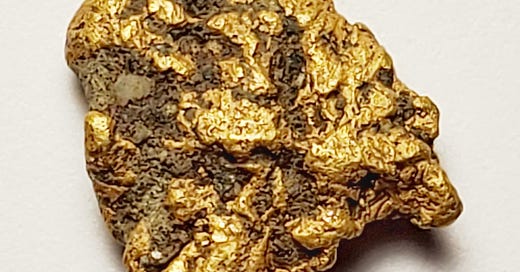Life in the USA is not normal. It feels pointless and trivial to be talking about small looks at the fascinating natural world when the country is being dismantled. But these posts will continue, as a statement of resistance. I hope you continue to enjoy and learn from them. Stand Up For Science!
For anyone who happens to be attending the Butte Mineral Show this weekend (17-18 May, 2025), I’ll have an educational display there about the mineralogy of Sherman Butte, west of Rocker, Montana. I’ve posted about the rocks there previously: Barite and the brecciation, and this one, which touches on the jasper, fluorite, and barite and their relationship to the underlying granite. Eventually, I plan to make a formal report on the mapping I’ve done out there, but not quite yet.
This little gold nugget is from Atlin, in far northwest British Columbia, Canada. The rocks that host the gold there are within the Cache Creek-Atlin Terrane, a discrete fault-bounded tectonic block containing radiolarian cherts, ultramafic rocks, volcanics, and greywackes, all of which suggest deep-sea materials probably deposited directly on oceanic crust. The block became amalgamated to North America during the long series of collisions that built the North American Cordillera. The rocks span 100 million years in age from Mississippian to Triassic, about 330 to 230 million years ago, and they were probably accreted to North America between Early Jurassic (about 180 million years ago) and Late Cretaceous (around 90 million years ago) time.
It seems that the gold mineralization followed faults that developed as the Cache Creek Terrane began to interact with other blocks in Late Triassic time, perhaps 210 million years ago. Much later, about 71 to 73 million years ago (Cretaceous) granitic batholiths (similar to Montana’s Boulder Batholith) intruded, bringing significant additional mineralization, but the gold appears to be older than those granites.
As mountain building continued, the rocks including the gold were eroded to form sedimentary deposits. Those with heavy minerals like gold are called placers (the word ‘placer’ comes from Spanish words meaning deposit, shoal, sandbank). The Atlin placers are among the richest in British Columbia and began to form before the most recent glacial period (beginning 2 million or so years ago). We know that because the old gold placers are partly buried beneath glacial lake deposits and moraines.
Because of its rounded, flat geometry, we know that this nugget is certainly from a placer rather than a lode deposit. Major production from Atlin’s placers began in 1898 and yielded more than 19,000 kg of gold (42,000 pounds, or 670,000 ounces). This nugget represents about 0.057 ounces of that total.
It was a gift from Bob & Marian Lankston, co-founders with me of the Tobacco Root Geological Society, whose 50th annual field conference will be this coming summer. They got it when they were doing some geophysical consulting in Atlin in the 1980s. Given the price of gold today (early May 2025), the melt value of this 1.61-gram nugget is about US$173.00 if it were pure gold. I think it is more valuable as a specimen, at least to me!
Atlin’s name comes from “Áa Tlein,” the Tlingit language phrase for "big body of water," a reference to Lake Atlin, which occupies a long, linear glacial valley that would be a fjord if it were connected to the ocean. The village of Atlin is 92 km by air from Skagway, Alaska – but 249 km by road.
For more information about the Atlin deposits, see Bloodgood et al. (1989, Geology and Mineralization of the Atlin Area, Northwestern British Columbia: British Columbia Ministry of Energy, Mines, and Petroleum Resources, Paper 1989-1, p. 311-322).
“All the gold ever mined in the world (about 4 billion ounces) would fit into a cube about 20 meters (65 feet) on a side.” – Gibson, 2011, “What Things Are Made Of,” p. 169.






That photo of the placer mining reminds one of how difficult those conditions were.
re: the "all the gold ever mined" quote is interesting and made me ask how much is undiscovered. I remember reading that there is gold in the ocean waters that's not practical to recover, and so there is an estimate that the amount mined is about 1% of the total estimated to be in the ocean. Have you heard similar numbers?
Thank you and BTW I think it's never trivial or pointless to be taking small looks at nature.